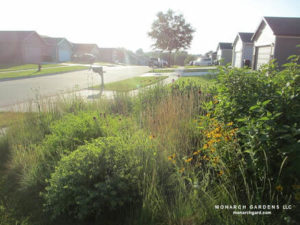By Benjamin Vogt
prairie inspired garden design and author of A NEW GARDEN ETHIC
Creating a new pollinator garden for your yard can be daunting, especially when you  are new to a lot of the design and environmental principles that make up a great garden. It’s a lot to remember, from choosing the wrong plants for the site, to matching those plants to one another, But it’s not all that complex (well, maybe it is) especially after you’ve learned a few basic principles and dive in after you’ve done some healthy research. This article attempts to distill what makes a natural pollinator garden beautiful for wildlife and people, all while requiring less management (water, mulch, fertilizer) than a typical garden.
are new to a lot of the design and environmental principles that make up a great garden. It’s a lot to remember, from choosing the wrong plants for the site, to matching those plants to one another, But it’s not all that complex (well, maybe it is) especially after you’ve learned a few basic principles and dive in after you’ve done some healthy research. This article attempts to distill what makes a natural pollinator garden beautiful for wildlife and people, all while requiring less management (water, mulch, fertilizer) than a typical garden.
learning about plants
So yes, you have to research plants. You can just trust a plant tag or even a sales person, especially because when you put a little legwork in you learn your way, way, way more. So let’s say you’ve just picked up a pale purple coneflower, Echinacea pallida. The plant tag likely says it needs full sun and dry soil. That tag can’t fit enough pertinent info on there to help you garden with more success, such as: what TYPE of soil; how it actually performs in various conditions; what wildlife it literally grows. Is it even native to the local ecoregion? Go online and type a search in for “Echinacea pallida.” Websites that I’ve found the most helpful in learning about plants in flyover country include:
Prairie Moon Nursery
Prairie Nursery
Illinois Wildflowers
Missouri Botanical Garden
Lady Bird Johnson Wildflower Center
Once you’ve read about the plants from these sites — and even a local or regional book — you’ll know more than most folks and you can plant with much more ecological confidence.
What you’ll discover about Echinacea pallida is that it has a deep tap root, and planted as a plug it will take 1-2 years before flowering as it works on that tap root. You’ll learn it prefers leaner, drier soils but can thrive in the moisture swings of clay soil. You’ll learn it’s a clumper that, in bare soil, will lightly self sow. Since it has a deep taproot it works well among other plants that have more fibrous root zones, that way the plants aren’t always competing for the same resources. You’ll learn its flower stalks get taller in more rich soil and that its basal foliage stays relatively short to the ground, with long fuzzy leaves. Since its foliage isn’t all that dense or large, other plants that require more sunlight — including ground covers — will do well right next to it. You may even discover in your reading that the dried flower heads, nearly jet black, remain all winter, and how cool they look with a backdrop of short prairie grasses (like little bluestem) as the winter sun filters in behind them.
